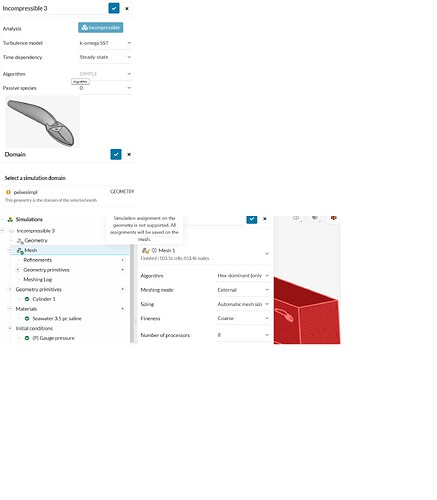Project Underwater in SimScale.
The rigid body is tied with a 30m fishing line so I think I could say that the tying point is always at the same X coordinate (aproximation). I want to test the underwater movements and the inclination of the tying line.
I can not make a simulation and I don’t know if I can create conditions to simulate the behavour of the rigid body tied with a line.
Can someone help?
Hi @fernando_silva,
Please post your project link so we can better understand the problem.
As for your simulation case, I would assume you want to know the forces acting on the line? Or do you want to see the expected movement of the line due to specific flow directions/magnitudes?
If its the first case, you can only do so for a fixed location and fixed flow direction. For the second case, likewise but I don’t think it is possible to simulate an actual reaction of the line. Maybe a 6DOF simulation may be possible.
So with that being said, your objective is not very clear, do elaborate exactly what kind of data you want to extract from the simulation and your expected conditions.
Cheers.
Regards,
Barry
The link of the project is SimScale.
I am new in this hobby and I have been playing around with SimScale to learn and understand concepts.
So for now the problem is simplified.
I think that the correct simulation must take in account 2 forces that I don’t know if I can simulate with this tool: 1-There is a line tied to the front part of the body (the little sphere) and tied to a fixed point outside water. It could be seen like a strong spring, if possible, or like a rigid line that the results probably are almost the same. In the limit we can say that the sphere moves only in a vertical plane.
2-There is the impulsion of the body because the body and part of the head are low density. I think I can simulate that with an upward force applied in a point inside the body (centroid of volume).
And there is the most important, the force of the water moving around the body. When the water flows it makes the head go down and the body oscillates and go deeper. Until a point where the vertical component of the force of the line prevents getting lower and the body remains moving around an horizontal plane.
I would like to know the angle of the line with the water and I would like to see the movement and the orientation of the body inside water in such situation (equilibrium).
Do you think I can do the correct simulation taking in account the 2 forces, line and impulsion?
Hi @fernando_silva,
This is a very unique case indeed.
From what I can understand, you want to apply forces and conditions to two connected but different geometries or maybe one single geometry but two different forces and then deduce the reaction based on it.
While that is totally possible to apply two different forces onto a single body or two different connected bodies, it is not possible to deduce the movement or reaction over time as the forces are applied. What you can get is simply a single state and reaction of those forces and the geometry will still be fixed in space.
Basically, you will never see movement of any of the geometries no matter what you do. To produce this motion you will need something like a moving mesh, which SimScale does not have but the native solver OpenFOAM does. However, as far as I know, it is not easy at all to implement considering the complexity of what you are trying to replicate.
I suggest instead is to narrow down to singular tasks that can then be “stitched” together to build a semi-complete picture of what you are trying to find out.
I’ll tag my fellow @cfd_squad and see if they have a workaround to achieve what you want. But for sure, a reactionary movement due to the forces and over time is not possible here.
Cheers.
Regards,
Barry
@Get_Barried: My ‘workaround’ would be to try to modulate inlet angle (rotating flow), but as we know from my Pandora Box project, currently rotating flow is not reporting correctly the forces acting on a body. When it is fixed globally in SimScale, perhaps some insights can be gained from applying rotating flow…
@fernando_silva: When you have ‘Velocity inlet’, please use ‘Pressure outlet’, not ‘Velocity outlet’. Moreover, as "Velocity inlet is on X+, defined velocity should be negative on X axis, such a -2 m/s, as flow goes toward X-. In order to start simulation, you have to define your tunnel ‘walls’, at least as ‘slip’ walls for the beginning. In ‘Results control’ define ‘Forces and Moments’ on you body, to see how it reacts to the flow
Cheers,
Retsam
Thank you. It runned.
I think I can say there is a strong force facing down (pressure force Z).
Fernando
